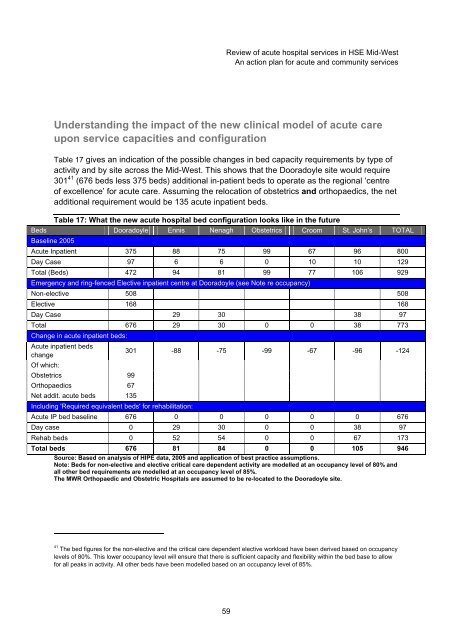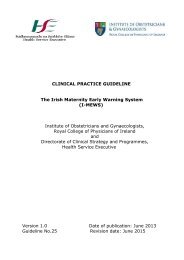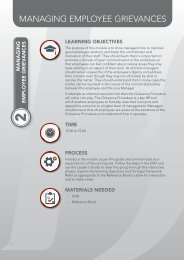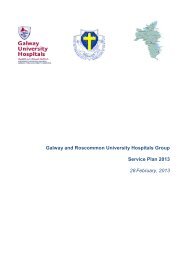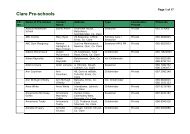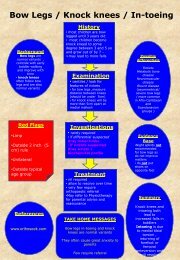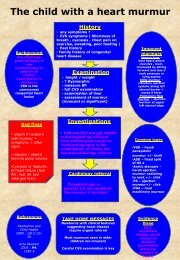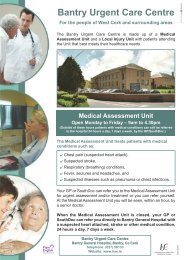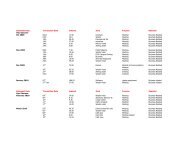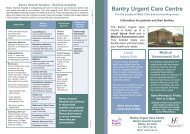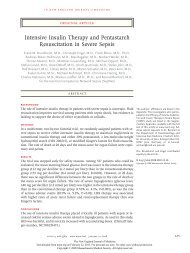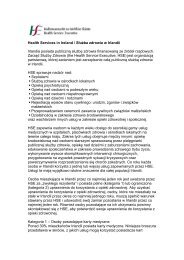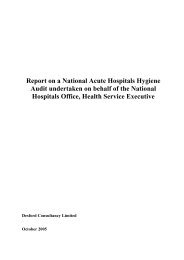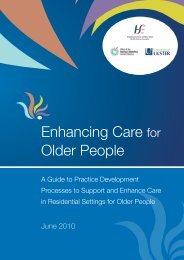Review of acute hospital services in the Mid - Health Service Executive
Review of acute hospital services in the Mid - Health Service Executive
Review of acute hospital services in the Mid - Health Service Executive
- TAGS
- acute
- www.hse.ie
Create successful ePaper yourself
Turn your PDF publications into a flip-book with our unique Google optimized e-Paper software.
<strong>Review</strong> <strong>of</strong> <strong>acute</strong> <strong>hospital</strong> <strong>services</strong> <strong>in</strong> HSE <strong>Mid</strong>-West<br />
An action plan for <strong>acute</strong> and community <strong>services</strong><br />
Understand<strong>in</strong>g <strong>the</strong> impact <strong>of</strong> <strong>the</strong> new cl<strong>in</strong>ical model <strong>of</strong> <strong>acute</strong> care<br />
upon service capacities and configuration<br />
Table 17 gives an <strong>in</strong>dication <strong>of</strong> <strong>the</strong> possible changes <strong>in</strong> bed capacity requirements by type <strong>of</strong><br />
activity and by site across <strong>the</strong> <strong>Mid</strong>-West. This shows that <strong>the</strong> Dooradoyle site would require<br />
301 41 (676 beds less 375 beds) additional <strong>in</strong>-patient beds to operate as <strong>the</strong> regional ‘centre<br />
<strong>of</strong> excellence’ for <strong>acute</strong> care. Assum<strong>in</strong>g <strong>the</strong> relocation <strong>of</strong> obstetrics and orthopaedics, <strong>the</strong> net<br />
additional requirement would be 135 <strong>acute</strong> <strong>in</strong>patient beds.<br />
Table 17: What <strong>the</strong> new <strong>acute</strong> <strong>hospital</strong> bed configuration looks like <strong>in</strong> <strong>the</strong> future<br />
Beds<br />
Basel<strong>in</strong>e 2005<br />
Dooradoyle Ennis Nenagh Obstetrics Croom St. John’s TOTAL<br />
Acute Inpatient 375 88 75 99 67 96 800<br />
Day Case 97 6 6 0 10 10 129<br />
Total (Beds) 472 94 81 99 77 106 929<br />
Emergency and r<strong>in</strong>g-fenced Elective <strong>in</strong>patient centre at Dooradoyle (see Note re occupancy)<br />
Non-elective 508 508<br />
Elective 168 168<br />
Day Case 29 30 38 97<br />
Total 676 29 30 0 0 38 773<br />
Change <strong>in</strong> <strong>acute</strong> <strong>in</strong>patient beds:<br />
Acute <strong>in</strong>patient beds<br />
change<br />
301 -88 -75 -99 -67 -96 -124<br />
Of which:<br />
Obstetrics 99<br />
Orthopaedics 67<br />
Net addit. <strong>acute</strong> beds 135<br />
Includ<strong>in</strong>g 'Required equivalent beds' for rehabilitation:<br />
Acute IP bed basel<strong>in</strong>e 676 0 0 0 0 0 676<br />
Day case 0 29 30 0 0 38 97<br />
Rehab beds 0 52 54 0 0 67 173<br />
Total beds 676 81 84 0 0 105 946<br />
Source: Based on analysis <strong>of</strong> HIPE data, 2005 and application <strong>of</strong> best practice assumptions.<br />
Note: Beds for non-elective and elective critical care dependent activity are modelled at an occupancy level <strong>of</strong> 80% and<br />
all o<strong>the</strong>r bed requirements are modelled at an occupancy level <strong>of</strong> 85%.<br />
The MWR Orthopaedic and Obstetric Hospitals are assumed to be re-located to <strong>the</strong> Dooradoyle site.<br />
41 The bed figures for <strong>the</strong> non-elective and <strong>the</strong> critical care dependent elective workload have been derived based on occupancy<br />
levels <strong>of</strong> 80%. This lower occupancy level will ensure that <strong>the</strong>re is sufficient capacity and flexibility with<strong>in</strong> <strong>the</strong> bed base to allow<br />
for all peaks <strong>in</strong> activity. All o<strong>the</strong>r beds have been modelled based on an occupancy level <strong>of</strong> 85%.<br />
59


